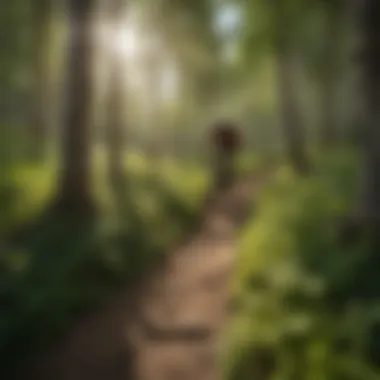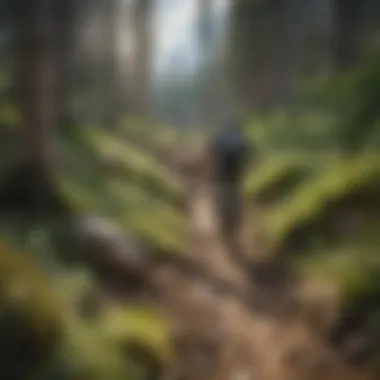Mountain Bike Trails in Crested Butte: Explore the Best


Intro
Crested Butte, Colorado, has gained a reputation as a prime destination for mountain biking enthusiasts. The stunning landscapes, variable terrains, and rich ecological environment make it an appealing place for riders of all skill levels. This article presents an explicit exploration of mountain biking trails in the region, shedding light on the various trails, their difficulties, and the associated ecological aspects. It also looks at the implications of mountain biking on local conservation efforts, maintenance practices, and the broader community’s role in fostering sustainable outdoor recreation.
Whether you are a seasoned biker or new to the sport, the insights here will help you navigate your biking adventure effectively. We seek to highlight not just the thrill of mountain biking but also the importance of safety, community, and environmental stewardship.
Crested Butte offers a rich network of trails, which we will explore in detail. Each trail presents unique challenges and breathtaking views, allowing riders to immerse themselves in the natural beauty of the Colorado Rockies. As we delve into the specifics, this guide will serve as a thorough companion for understanding what makes mountain biking in Crested Butte a remarkable experience.
Prelims to Mountain Biking in Crested Butte
Mountain biking has established itself as a prominent outdoor activity in Crested Butte, Colorado. This small town is often seen as a mecca for mountain bikers. The importance of this topic lies in its potential to attract new perspectives on outdoor recreation and sustainability. The trails here are not only about adventure; they are intertwined with the local culture and ecology. In this exploration, we will discuss various elements contributing to this reputation, such as unique terrains, community involvement, and historical significance.
Historical Context of Mountain Biking
In the late 1970s and early 1980s, mountain biking emerged from California but soon reached Crested Butte. The local riders began modifying bikes for off-road riding. They created some of the first dedicated mountain bike trails in the region. This created a fertile ground for the sport's evolution, incorporating both technical skills and physical endurance.
Over the decades, the sport grew in popularity. Events like the annual Enduro World Series and the Crested Butte Fat Tire Festival exemplify the local commitment to mountain biking. Today, Crested Butte is often seen as a pivotal location in the history of mountain biking, influencing trail design and riding communities across the nation.
Significance of Crested Butte in the Biking Community
Crested Butte is significant for several reasons. The diversity of trails here is unparalleled, offering options for every skill level. From beginner-friendly paths to challenging singletracks, every biker's need is addressed. Furthermore, the breathtaking scenery adds an aesthetic value to the riding experience.
The biking community plays a critical role in maintaining these trails. Local organizations like the Crested Butte Mountain Bike Association are instrumental in conservation efforts and ensuring that trails remain accessible and well-maintained. Their work emphasizes a sustainable approach to recreation, balancing fun with environmental responsibility.
"Crested Butte has built a strong biking culture that empowers and engages riders, promoting an eco-conscious mindset."
In summary, understanding mountain biking in Crested Butte opens the door to appreciating the intricate relationship between recreation, community, and ecology. Each trail tells a story, and each ride creates connections among riders, nature, and the local economy.
Overview of Crested Butte Trails
Crested Butte offers an extraordinary range of trails that cater to bikers of all experience levels. This section provides a foundational understanding of the trails available, emphasizing their significance in the biking culture of this location.
The area’s unique topography contributes to the diversity of its trails. Riders can expect to encounter an array of terrains, including steep climbs, winding paths through dense forests, and open meadows that present breathtaking views. These characteristics attract enthusiasts from various backgrounds, making Crested Butte a notable destination in the biking community.
Understanding the types of trails available is essential for riders seeking to match their skills with appropriate challenges.
Trail Classification and Grading
Trail classification is a critical aspect for both new and seasoned riders. The grading system helps individuals gauge what to expect regarding difficulty. In Crested Butte, trails are classified as green (easy), blue (intermediate), and black (difficult).
- Green Trails: Suitable for beginners, these paths typically feature gentle gradients and wide surfaces, allowing for a comfortable experience.
- Blue Trails: Designed for more experienced bikers, these trails may present some obstacles and steeper sections, requiring better handling and fitness.
- Black Trails: Meant for expert level riders, black trails challenge with steep descents, technical features, and possible exposure to drop-offs.
This classification aids bikers in selecting the right trail, ensuring a fulfilling and safe biking experience.
Environmental Considerations
Mountain biking in Crested Butte intersect with environmental factors that are crucial to both trails and the surrounding ecosystem. Riders must understand the impact of their activities on local wildlife and vegetation.
Maintaining sustainable practices is vital in preserving the natural beauty and biodiversity of the area.
Factors to consider include:


- Trail Impact: Each bike that traverses a trail contributes to wear and erosion, which can adversely affect vegetation and soil stability.
- Wildlife Hazards: Bikers should be mindful of wildlife, especially during breeding seasons. Encounters can disrupt their habitat and life cycles.
- Weather Dependency: Soil conditions can change significantly due to rain or snow, impacting trail safety. Biking during wet conditions may lead to damaging trails and harming the environment.
To mitigate these impacts, it is important for bikers and local organizations to promote responsible usage of trails and engage in conservation efforts.
"Sustainable practices in mountain biking not only protect the trails but also enhance the experience for all users."
Being aware of these environmental considerations will not only enrich the personal biking adventure but will also contribute positively to the greater community of bikers in Crested Butte.
Featured Mountain Bike Trails
In Crested Butte, the mountain bike trails are more than mere routes; they embody a rich landscape of experiences and challenges. Each trail offers unique characteristics while contributing to the overall biking culture in this vibrant region. The featured trails not only provide diverse terrains suitable for different skill levels, but they also showcase the natural beauty of the area, making them a significant part of any mountain biking itinerary.
Baker's Dozen
Trail Description
Baker's Dozen is a celebrated trail known for its blend of technical sections and flowy descents. This trail features tight turns and moderate elevation changes that challenge riders while also offering moments of pure exhilaration. Its popularity stems from the stunning views it provides, particularly in the autumn when the foliage changes colors. The mixed terrain allows bikers to experience a harmonious connection with the environment.
Difficulty Level
The difficulty of Baker's Dozen is classified as intermediate, which makes it accessible for many riders seeking to step up their skills. It requires a certain familiarity with technical riding, such as navigating rocky sections and controlling speed through turns. This difficulty level encourages growth and learning, which is advantageous for those wishing to elevate their biking capabilities.
Access Points
Access to Baker's Dozen is well-marked, with several entry points available from the main road. Notably, the ease of access is beneficial for both locals and visitors, allowing for spontaneous riding adventures. However, the trail can become crowded during peak times, which might be a disadvantage for those seeking solitude.
Snodgrass Trail
Trail Description
The Snodgrass Trail offers a more scenic and leisurely biking experience. This trail winds through lush forests, providing ample shade and a cooler ride on warm days. Its less technical nature makes it appealing for families and beginners. The elevation gain is gradual, making it suitable for riders who prefer a stable pace while absorbing their surroundings.
Difficulty Level
Classified as an easy trail, Snodgrass is perfect for novice bikers. Its manageable slopes and fewer obstacles offer a safe environment to build confidence. Despite its simplicity, the trail is rewarding, providing beautiful vistas and a connection to nature that novices often seek.
Access Points
There are several points to enter Snodgrass, each featuring clear signage. Its proximity to popular gathering areas makes it easy for riders to access. However, this can also result in a busier trail, which may detract from the experience for those looking for more space.
Upper Loop
Trail Description
Upper Loop presents a more challenging aspect for dedicated bikers. With sharp climbs and descents, it tests endurance and bike handling skills. The trail’s design flows seamlessly with the natural hillsides, creating an exhilarating experience for those who conquer its path. Views from the top are especially rewarding, revealing the expansive mountain ranges and valleys below.
Difficulty Level
Marked as advanced, Upper Loop is best suited for experienced riders. The steep grades and technical aspects demand a high skill level. Riders will find that this trail pushes their limits, both physically and mentally, enhancing their overall mountain biking proficiency.
Access Points
Access to Upper Loop is straightforward, with well-maintained dirt roads leading to the starting point. However, its location can contribute to safety concerns during adverse weather conditions. Some riders may seek alternative routes if conditions deteriorate.


Lower Loop
Trail Description
Lower Loop is often considered a complementary experience to Upper Loop. It provides a smoother ride with flowing sections that contrast the rigors of the Upper Loop. The trail features wide paths that accommodate varying riding styles, making it appealing for those looking to unwind after more challenging rides.
Difficulty Level
Difficulty for Lower Loop is classified as moderate. Riders of varying abilities can enjoy this trail, though some segments may present minor challenges. It acts as a good cross-training opportunity for those preparing for more demanding rides.
Access Points
Accessing Lower Loop is simple, with its trailhead being easily navigable from popular biking areas. It is well-suited for quick jaunts or extended day rides, although its popularity can lead to busy conditions during weekends.
"Crested Butte offers a unique balance of terrains and vistas that declare it as a top destination for mountain bikers of all experience levels."
In summary, these featured mountain bike trails in Crested Butte provide a vast array of choices for riders. The variety ensures that everyone, from beginners to advanced bikers, can find a suitable trail that fits their skill level while enjoying the breathtaking backdrops of the region.
Safety and Preparation
Safety and preparation are critical components of enjoying mountain biking in Crested Butte. The diverse landscapes and variable terrain add excitement, but they also present potential risks. Every rider, regardless of experience, must prioritize their safety and that of others on the trails. Being well-prepared can make the difference between an enjoyable ride and a hazardous situation.
Gear Essentials
Having the right gear is essential for a safe biking experience. Here are the key items to ensure:
- Helmet: Always wear a certified helmet. This is your primary protection against head injuries.
- Gloves: Good gloves enhance grip and protect against blisters and abrasions.
- Hydration Pack: Staying hydrated is crucial, especially in dry, elevated terrains.
- Repair Kit: A basic repair kit, including spare tubes, a tire lever, and a multi-tool, can save a ride from a simple mechanical failure.
- First Aid Kit: Accidents can happen. A small first aid kit allows for immediate treatment of minor injuries.
These essentials help in addressing common issues encountered on the trails and ensure you are well-equipped for unexpected challenges.
Trail Etiquette
Understanding and practicing good trail etiquette is vital in maintaining a positive mountain biking community. Here are some key points to consider:
- Yield to Others: Uphill riders should be given the right of way. This is crucial for safe passage.
- Stay on Designated Trails: Venturing off-trail can damage the surrounding vegetation and soil. Always stick to marked paths.
- Control Your Speed: Be mindful of your speed, especially in areas where there may be other riders, hikers, or wildlife.
- Leave No Trace: Carry out what you bring in. This ensures the trails remain pristine for others.
Good etiquette fosters a sense of community and helps promote a sustainable biking environment.
Weather Considerations
Weather can change rapidly in the mountainous regions of Crested Butte. It is crucial to be aware of the conditions before setting out. Here are some practical tips regarding weather:
- Check Forecasts: Always check the local weather forecast before your ride. Look for potential storms or extreme conditions.
- Dress Appropriately: Layering is key. Weather can shift from warm to cold quickly. Ensure you have a waterproof layer if rain is likely.
- Awareness of Altitude: Be mindful of the elevation. Conditions can be different from what you experience at lower altitudes.
- Lightning Awareness: Storms can develop suddenly. Be ready to seek shelter if thunderstorms approach.
By remaining informed about the weather conditions, you can significantly improve your safety and enjoyment on the trails.
Safety is not merely a choice; it is an obligation toward oneself and others. Enjoy the trails, but do so wisely.
The Ecological Impact of Mountain Biking
Mountain biking brings joys of exploration and outdoor recreation, but it also poses significant ecological impacts worth exploring. Understanding these effects is crucial for bikers and conservationists alike. This section will delve into both the environmental effects and the initiatives aimed at mitigating these impacts.


Environmental Effects
Mountain biking can introduce changes to ecosystems that merit attention. The primary areas of concern include:
- Soil Erosion: Frequent biking on natural paths can lead to soil compaction and erosion, particularly on steep or loose terrain. This disrupts vegetation growth and can contribute to sediment runoff into nearby waterways, altering aquatic habitats.
- Wildlife Disturbance: Increased presence of bikers can disturb local wildlife, especially during sensitive breeding seasons. Animals may alter their natural behaviors, potentially leading to population declines in vulnerable species.
- Invasive Species: Bikes can inadvertently introduce invasive plant species, as seeds may cling to tires and gear. This can negatively affect local flora and fauna, often outcompeting native plants for resources.
Addressing these environmental challenges is essential for sustainable mountain biking. Efforts should focus on creating better trails that minimize erosion and protect wildlife habitats.
Conservation Initiatives
Community-driven conservation initiatives play a vital role in balancing the enjoyment of mountain biking with ecological health. Here are some noteworthy efforts:
- Trail Maintenance Programs: Local trail organizations, such as Crested Butte Mountain Bike Association, work tirelessly to maintain trails. Regular maintenance reduces erosion and keeps trails sustainable.
- Preventative Education Campaigns: Educating mountain bikers on the importance of respecting nature is key. Workshops and signage can inform bikers about staying on marked trails to prevent habitat disruption and erosion.
- Collaborative Conservation Efforts: In partnership with local authorities and environmental groups, many communities are creating multi-use trails that cater to biking while preserving ecological integrity. These efforts ensure that recreational use can coexist with conservation goals.
"Responsible mountain biking is not just about the ride; it's about protecting the environment we cherish."
Community Engagement and Support
Community engagement is a vital component of successful mountain biking ecosystems, particularly in places like Crested Butte. Active participation from local residents and biking enthusiasts promotes sustainable practices while fostering a strong sense of unity among trail users. Such engagement contributes not only to the maintenance and development of trails, but also to the promotion of responsible riding practices. Through community support, local organizations can better manage resources, advocate for biking needs, and educate new riders about their responsibilities in preserving the trail environment.
Moreover, engaging with the community helps combat potential conflicts between different outdoor recreational users. This interaction is crucial for creating a culture that values conservation and respect for nature. Having a shared vision and commitment to community-led initiatives ensures that the trails are protected for future generations while enhancing the biking experience for all users.
Local Organizations
Several local organizations play a pivotal role in supporting mountain biking activities within Crested Butte. Groups such as the Crested Butte Mountain Bike Association and the Gunnison Valley Mountain Biking Coalition emphasize trail maintenance, education, and environmental stewardship. Their efforts include organizing volunteer days where members can come together to repair trails, install signage, and perform regular upkeep. These activities not only stabilize trail surfaces but also foster camaraderie among participants.
In addition to maintenance, these organizations conduct workshops and training sessions. They educate riders about the ecological impact of mountain biking and the importance of adhering to sustainable practices.
Membership in local biking organizations often presents opportunities to influence decision-making regarding trail access and expansions. Active members can voice their opinions and provide insights into the biking community's needs. This connection between local advocates and authorities can lead to positive changes ensuring that biking remains a priority in land management decisions.
Events and Competitions
Events and competitions serve as critical avenues for community engagement and support. Annual races, fun rides, and festivals draw both local and visiting bikers, reinforcing a collective passion for the sport. Events like the Crested Butte Bike Week showcase the vibrancy of the biking culture and provide platforms for individuals to connect, share experiences, and learn from one another.
These gatherings often include a variety of activities suitable for all skill levels, promoting inclusivity. From guided trail rides to skill-building clinics, the focus on participation over competition strengthens community ties. Competitions within these events not only showcase the talents of local riders but also attract attention from outside the area, stimulating tourism and economic growth.
Moreover, proceeds from events typically support local trail initiatives and conservation projects, ensuring that any funds raised directly benefit the mountain biking community. Thus, events and competitions are not just recreational; they intertwine with larger community objectives, creating sustainable opportunities for everyone involved.
"Community engagement is about collaboration, understanding, and respect for one another's passions and the environment in which we ride."
By fostering connections through local organizations and actively participating in events, communities can cultivate an atmosphere that prioritizes stewardship and celebrates the joy of mountain biking.
Closure
The conclusion of this article emphasizes the multifaceted significance of mountain biking in Crested Butte. As we have explored, mountain biking is not only a cherished recreational activity but also a critical component of local culture and economy. The detailed examination of trails, safety guidelines, and environmental impacts outlined throughout this piece illustrates the breadth of considerations surrounding this sport.
Future of Mountain Biking in Crested Butte
The future of mountain biking in Crested Butte appears promising, thanks to a combination of community support, ongoing advocacy for sustainable practices, and the continuous enhancement of trail systems. Local organizations, such as the Crested Butte Mountain Bike Association, play a pivotal role in promoting the vitality of biking in this area. Their efforts include maintaining trails and organizing events that bring enthusiasts together.
Several key elements influence the future trajectory of mountain biking here:
- Trail Expansion: New trails are consistently being developed, catering to various skill levels. This not only attracts more bikers but also helps alleviate congestion on popular routes.
- Sustainability Initiatives: As awareness of ecological impacts increases, biking communities are embracing eco-friendly practices. Efforts to conserve local habitats while allowing for recreational activities will be essential.
- Increased Participation: The growing popularity of mountain biking ensures a vibrant community. With visitors and locals alike engaging in biking activities, the culture surrounding the sport continues to thrive.
- Technological Advancements: Innovations in biking equipment also offer opportunities for better bike performance and rider safety, further enhancing the mountain biking experience.
As these elements converge, Crested Butte can maintain its reputation as a premier destination for mountain biking enthusiasts. The local landscape offers endless possibilities for exploration, with trails that inspire riders to engage deeply with the environment. With sustainable practices at the forefront, the future holds great promise for both the biking community and the natural world that supports it.
"Sustainable mountain biking ensures that we preserve the beauty of our landscapes for generations to come."
In summary, the future of mountain biking in Crested Butte is bright, shaped by community engagement and a commitment to sustainability. Riders benefit from an ever-evolving trail system while simultaneously contributing to the ecological and cultural fabric of the region.



